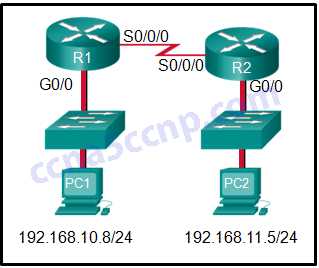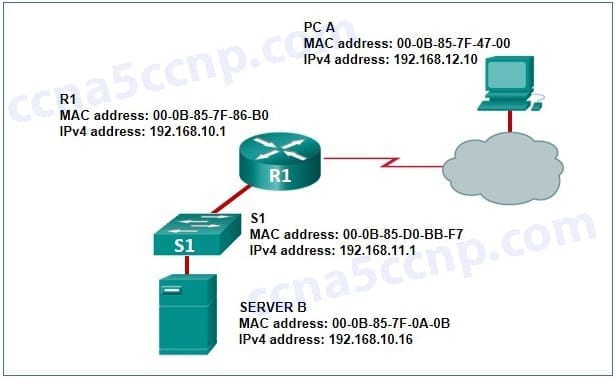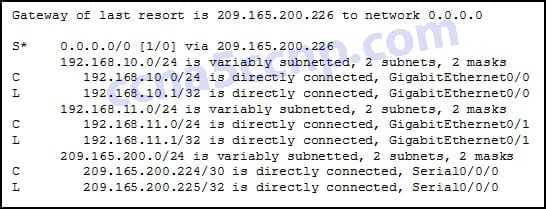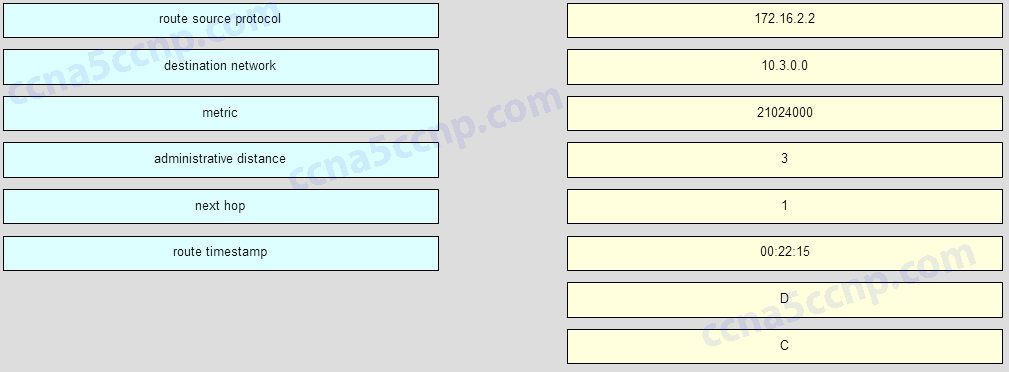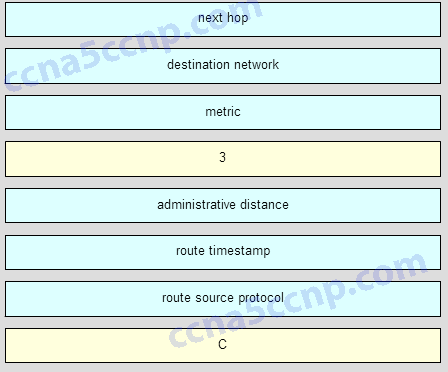Last Updated on April 3, 2018 by Admin
CCNA2 Chapter 4 Exam Answer 2016 v5.03
From year to year, Cisco has updated many versions with difference questions. The latest version is version 6.0 in 2018. What is your version? It depends on your instructor creating your class. We recommend you to go thought all version if you are not clear. While you take online test with netacad.com, You may get random questions from all version. Each version have 1 to 10 different questions or more. After you review all questions, You should practice with our online test system by go to "Online Test" link below.
| Version 5.02 | Version 5.03 | Version 6.0 | Online Assessment |
| Chapter 4 Exam | Chapter 4 Exam | Chapter 4 Exam | Online Test |
| Next Chapter | |||
| Chapter 5 Exam | Chapter 5 Exam | Chapter 5 Exam | Online Test |
| Lab Activities | |||
| No Lab Activities | |||
-
What are two functions of a router? (Choose two.)
- It connects multiple IP networks.
- It controls the flow of data via the use of Layer 2 addresses.
- It determines the best path to send packets.
- It manages the VLAN database.
- It increases the size of the broadcast domain.
-
Which two statements correctly describe the concepts of administrative distance and metric? (Choose two.)
- Administrative distance refers to the trustworthiness of a particular route.
- A router first installs routes with higher administrative distances.
- The value of the administrative distance can not be altered by the network administrator.
- Routes with the smallest metric to a destination indicate the best path.
- The metric is always determined based on hop count.
- The metric varies depending which Layer 3 protocol is being routed, such as IP.
-
In order for packets to be sent to a remote destination, what three pieces of information must be configured on a host? (Choose three.)
- hostname
- IP address
- subnet mask
- default gateway
- DNS server address
- DHCP server address
-
Which software is used for a network administrator to make the initial router configuration securely?
- SSH client software
- Telnet client software
- HTTPS client software
- terminal emulation client software
-
Refer to the exhibit. PC A sends a request to Server B. What IPv4 address is used in the destination field in the packet as the packet leaves PC A?
- 192.168.10.10
- 192.168.11.1
- 192.168.10.1
- 192.168.12.16
-
Refer to the exhibit. A network administrator has configured R1 as shown. When the administrator checks the status of the serial interface, the interface is shown as being administratively down. What additional command must be entered on the serial interface of R1 to bring the interface up?
- IPv6 enable
- clockrate 128000
- end
- no shutdown
-
What is a characteristic of an IPv4 loopback interface on a Cisco IOS router?
- The no shutdown command is required to place this interface in an UP state.
- It is a logical interface internal to the router.
- Only one loopback interface can be enabled on a router.
- It is assigned to a physical port and can be connected to other devices.
-
What two pieces of information are displayed in the output of the show ip interface brief command? (Choose two.)
- IP addresses
- MAC addresses
- Layer 1 statuses
- next-hop addresses
- interface descriptions
- speed and duplex settings
-
A packet moves from a host on one network to a device on a remote network within the same company. If NAT is not performed on the packet, which two items remain unchanged during the transfer of the packet from source to destination? (Choose two.)
- destination IP address
- source ARP table
- source IP address
- source MAC address
- destination MAC address
- Layer 2 header
-
Which two items are used by a host device when performing an ANDing operation to determine if a destination address is on the same local network? (Choose two.)
- destination IP address
- destination MAC address
- source MAC address
- subnet mask
- network number
-
Refer to the exhibit. If PC1 is sending a packet to PC2 and routing has been configured between the two routers, what will R1 do with the Ethernet frame header attached by PC1?
- nothing, because the router has a route to the destination network
- remove the Ethernet header and configure a new Layer 2 header before sending it out S0/0/0
- open the header and replace the destination MAC address with a new one
- open the header and use it to determine whether the data is to be sent out S0/0/0
-
Refer to the exhibit.
What does R1 use as the MAC address of the destination when constructing the frame that will go from R1 to Server B?
- If the destination MAC address that corresponds to the IPv4 address is not in the ARP cache, R1 sends an ARP request.
- The packet is encapsulated into a PPP frame, and R1 adds the PPP destination address to the frame.
- R1 uses the destination MAC address of S1.
- R1 leaves the field blank and forwards the data to the PC.
-
Refer to the exhibit. What will the router do with a packet that has a destination IP address of 192.168.12.227?
- Drop the packet.
- Send the packet out the Serial0/0/0 interface.
- Send the packet out the GigabitEthernet0/0 interface.
- Send the packet out the GigabitEthernet0/1 interface.
-
Which two parameters are used by EIGRP as metrics to select the best path to reach a network? (Choose two.)
- hop count
- bandwidth
- jitter
- resiliency
- delay
- confidentiality
-
What route would have the lowest administrative distance?
- a directly connected network
- a static route
- a route received through the EIGRP routing protocol
- a route received through the OSPF routing protocol
-
Consider the following routing table entry for R1:
D 10.1.1.0/24 [90/2170112] via 209.165.200.226, 00:00:05, Serial0/0/0
What is the significance of the Serial0/0/0?
- It is the interface on R1 used to send data that is destined for 10.1.1.0/24.
- It is the R1 interface through which the EIGRP update was learned.
- It is the interface on the final destination router that is directly connected to the 10.1.1.0/24 network.
- It is the interface on the next-hop router when the destination IP address is on the 10.1.1.0/24 network.
-
Refer to the exhibit. A network administrator issues the show ipv6 route command on R1. What two conclusions can be drawn from the routing table? (Choose two.)
- R1 does not know a route to any remote networks.
- The network FF00::/8 is installed through a static route command.
- The interface Fa0/1 is configured with IPv6 address 2001:DB8:ACAD:A::12.
- Packets that are destined for the network 2001:DB8:ACAD:2::/64 will be forwarded through Fa0/1.
- Packets that are destined for the network 2001:DB8:ACAD:2::54/128 will be forwarded through Fa0/0.
-
A network administrator configures the interface fa0/0 on the router R1 with the command ip address 172.16.1.254 255.255.255.0. However, when the administrator issues the command show ip route, the routing table does not show the directly connected network. What is the possible cause of the problem?
- The interface fa0/0 has not been activated.
- The configuration needs to be saved first.
- No packets with a destination network of 172.16.1.0 have been sent to R1.
- The subnet mask is incorrect for the IPv4 address.
-
A network administrator configures a router by the command ip route 0.0.0.0 0.0.0.0 209.165.200.226. What is the purpose of this command?
- to forward all packets to the device with IP address 209.165.200.226
- to add a dynamic route for the destination network 0.0.0.0 to the routing table
- to forward packets destined for the network 0.0.0.0 to the device with IP address 209.165.200.226
- to provide a route to forward packets for which there is no route in the routing table
-
What are two common types of static routes in routing tables? (Choose two)
- a default static route
- a built-in static route by IOS
- a static route to a specific network
- a static route shared between two neighboring routers
- a static route converted from a route that is learned through a dynamic routing protocol
-
What command will enable a router to begin sending messages that allow it to configure a link-local address without using an IPv6 DHCP server?
- the ipv6 route ::/0 command
- a static route
- the ip routing command
- the ipv6 unicast-routing command
-
Which statement describes a route that has been learned dynamically?
- It is automatically updated and maintained by routing protocols.
- It is unaffected by changes in the topology of the network.
- It has an administrative distance of 1.
- It is identified by the prefix C in the routing table.
-
Fill in the blank.
When a router receives a packet, it examines the destination address of the packet and looks in the Routing table to determine the best path to use to forward the packet. -
Refer to the exhibit. Match the description with the routing table entries. (Not all options are used.)
- Question
- Answer
From year to year, Cisco has updated many versions with difference questions. The latest version is version 6.0 in 2018. What is your version? It depends on your instructor creating your class. We recommend you to go thought all version if you are not clear. While you take online test with netacad.com, You may get random questions from all version. Each version have 1 to 10 different questions or more. After you review all questions, You should practice with our online test system by go to "Online Test" link below.
| Version 5.02 | Version 5.03 | Version 6.0 | Online Assessment |
| Chapter 4 Exam | Chapter 4 Exam | Chapter 4 Exam | Online Test |
| Next Chapter | |||
| Chapter 5 Exam | Chapter 5 Exam | Chapter 5 Exam | Online Test |
| Lab Activities | |||
| No Lab Activities | |||


